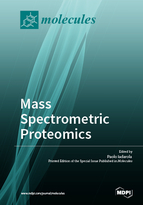Mass Spectrometric Proteomics
A special issue of Molecules (ISSN 1420-3049). This special issue belongs to the section "Analytical Chemistry".
Deadline for manuscript submissions: closed (31 December 2018) | Viewed by 52978
Special Issue Editor
Interests: purification and characterization of enzymes and structural proteins; investigation of the proteome of different tissues/fluids by using the conventional methods of proteomics/metabolomics
Special Issues, Collections and Topics in MDPI journals
Special Issue Information
Dear Colleagues,
A comprehensive understanding of the biochemical processes that govern life requires a deep understanding of the information encoded in the genome, and that relate to all protein forms expressed in a biological system, i.e., the proteome. While being complementary to each other, only proteome, that differs from cell to cell and changes, even for a single cell, in response to different stimuli, is descriptive of a biological phenotype. Detecting and quantifying all proteins, studying their post-translational modifications, level of expression, localization, interaction, and domain structure are the goals of proteomics. Because of its ability to handle the complexity of the events mentioned above, mass spectrometry (MS) has become an indispensable tool for proteomics. However, what does the term MS stand for? MS consists of a variety of analytical methods, each characterized by its own strengths for the solution of a peculiar problem and of which the choice depends on the aim of the study. The numerous developed applications of MS in proteomics, thus far, have contributed heavily to new insights into the roles played by some proteins in human disorders.
The aim of this Special Issue is to attract contributions on all aspects of MS-based proteomics with a special emphasis on recent/novel technologies that, by pushing the boundary of MS capabilities, make them able to address biological problems that have not yet been faced.
Prof. Dr. Paolo Iadarola
Guest Editor
Manuscript Submission Information
Manuscripts should be submitted online at www.mdpi.com by registering and logging in to this website. Once you are registered, click here to go to the submission form. Manuscripts can be submitted until the deadline. All submissions that pass pre-check are peer-reviewed. Accepted papers will be published continuously in the journal (as soon as accepted) and will be listed together on the special issue website. Research articles, review articles as well as short communications are invited. For planned papers, a title and short abstract (about 100 words) can be sent to the Editorial Office for announcement on this website.
Submitted manuscripts should not have been published previously, nor be under consideration for publication elsewhere (except conference proceedings papers). All manuscripts are thoroughly refereed through a single-blind peer-review process. A guide for authors and other relevant information for submission of manuscripts is available on the Instructions for Authors page. Molecules is an international peer-reviewed open access semimonthly journal published by MDPI.
Please visit the Instructions for Authors page before submitting a manuscript. The Article Processing Charge (APC) for publication in this open access journal is 2700 CHF (Swiss Francs). Submitted papers should be well formatted and use good English. Authors may use MDPI's English editing service prior to publication or during author revisions.
Keywords
- proteome
- mass spectrometry
- biological system
- genome
- protein forms
- biological phenotype
- expression, localization, interaction and domain structure of proteomics







